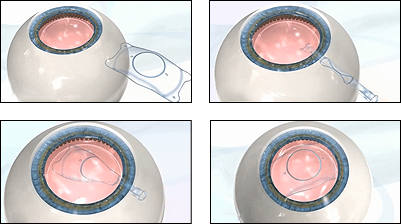A Lens-Based Vision Correction Option to Visual Freedom
by Craig Bindi, MD
The EVO ICL (Implantable Collamer Lens) is a lens implant, which is capable of correcting/reducing moderate to severe amounts of nearsightedness and astigmatism (ranging from –3.0 D to –20.0 D), which is well beyond the treatment range of LASIK (up to -12.0 D of nearsightedness and 4.0 D of astigmatism). The soft, flexible nature of the ICL allows it to be inserted through a self-sealing micro-opening that measures only ~3 millimeters. The EVO ICL is designed to stay permanently, but it could be removed or updated, if necessary. The lens is made of a material called Collamer, which filters ultraviolet light and is very well-tolerated within the eye.
Like a soft contact lens, the EVO ICL is soft & flexible
The U.S. FDA approved the original EVO ICL in 2005 after reviewing the long term data since 1995. In the FDA clinical studies, 526 eyes underwent the lens implant procedure, averaging -10 D of preoperative nearsightedness. Three years after the procedure, nearly 95% of patients had “20/40 vision or better” without glasses, which is good enough to pass the DMV test (4). These are remarkably good results considering the extremely high level of nearsightedness that was treated. The EVO ICL is the most updated version of the ICL, which has evolved to become safer than the original version.
Like LASIK: The EVO ICL procedure is painless

Lens implants/inserts have been used for over half a century in various forms of eye surgery, such as cataract surgery. With the EVO ICL, the eye’s natural lens is left in place. The lens implant procedure is done as an outpatient procedure, under topical eye drop anesthesia. Most patients experience little to no discomfort during the actual procedure, which takes about 15-20 minutes. Most patients report a nearly instantaneous improvement in their vision within hours, similar to LASIK.
Like nothing: It doesn’t require any daily care, and can’t be seen or “felt”
 In the FDA clinical studies, 93.6% of patients (averaging -12.6 D nearsightedness) saw “20/40 or better” without glasses one year after the procedure. At three years after the procedure, 92% of patients had uncorrected vision of “20/40 or better”, and 61.7% were seeing “20/25 or better” without any glasses (1). In a recent study published in the scientific journal Ophthalmology, for the treatment of extreme nearsightedness (between – 9.00D and –19.50D), 72.2% of patients who received underwent lens implants in one eye and LASIK in the other preferred the vision in the lens implant eye over the LASIK eye because of the better quality of vision (3)
In the FDA clinical studies, 93.6% of patients (averaging -12.6 D nearsightedness) saw “20/40 or better” without glasses one year after the procedure. At three years after the procedure, 92% of patients had uncorrected vision of “20/40 or better”, and 61.7% were seeing “20/25 or better” without any glasses (1). In a recent study published in the scientific journal Ophthalmology, for the treatment of extreme nearsightedness (between – 9.00D and –19.50D), 72.2% of patients who received underwent lens implants in one eye and LASIK in the other preferred the vision in the lens implant eye over the LASIK eye because of the better quality of vision (3)
EVO ICL helps nearsighted people be able to simply wake up & see!
Other Benefits of the EVO ICL
- Sharp, clear vision
- 99% patient satisfaction
- Over 1 million procedures performed worldwide
- Immediate improvement in vision
- Can be removed, if needed
- Offers UV protection
- Treats nearsightedness and astigmatism
- May be an option for patients who are not candidates for LASIK
- Does not cause dry eye syndrome
- Provides excellent night vision
Schedule VIRTUAL or IN-OFFICE Consultation
References:
1) Continued follow-up reinforces efficacy, safety of myopic phakic IOL. Ophthalmology Times, October 23, 2004. FDA Clinical Trials, Data on file, Ophtec USA, Inc.
2) El Danasoury MA, Maghraby AE, Gamali TO. Comparison of Iris-fixed Artisan Lens Implantation with Excimer Laser In Situ Keratomileusis in Correcting Myopia between –9.00 and –19.50 Diopters. Ophthalmology, 2002; 109:955-64.
3) FDA Clinical Trials, Data in file, Staar Surgical, Inc.
4) DR Sanders MD PHD, JA Vuchick MD. Comparison of Implantable Contact Lens and Laser Assisted In Situ Keratomileusis for Moderate to High Myopia. Cornea, 22 (4): 324-331, 2003.
5) Shin, JY. Ahn, H. Seo, KY. Kim, EK. Kim, TK. Comparison of higher order aberrations after implantable collamer lens implantation and wavefront-guide LASEK in high myopia. J Refract Surg. 2012; 28(2): 106 -111
6) MICL PMA data
7) Data on file. STAAR Surgical.
8) Parkhurst, G. Psolka, M. Kezirian, G. Phakic intraocular lens implantation in United States military warfighters: A retrospective analysis of early clinical outcomes of the Visian ICL. J Refract Surg. 2011;27(7):473 – 481
9) Naves, J.S. Carracedo, G. Cacho-Babillo, I. Diadenosine Nucleotid Measurements as Dry-Eye Score in Patients After LASIK and ICL Surgery. Presented at American Society of Cataract and Refractive Surgery (ASCRS) 2012.
10) Parkhurst G. A Prospective Comparison of Phakic Collamer Lenses and Wavefront-Optimized Laser-Assisted in Situ Keratomileusis for Correction of Myopia. Clinical Ophthalmology 2013; 10: 1209-1215.[/vc_column_text][/vc_column][/vc_row][vc_row css_animation=”” row_type=”row” use_row_as_full_screen_section=”no” type=”full_width” angled_section=”no” text_align=”left” background_image_as_pattern=”without_pattern”



